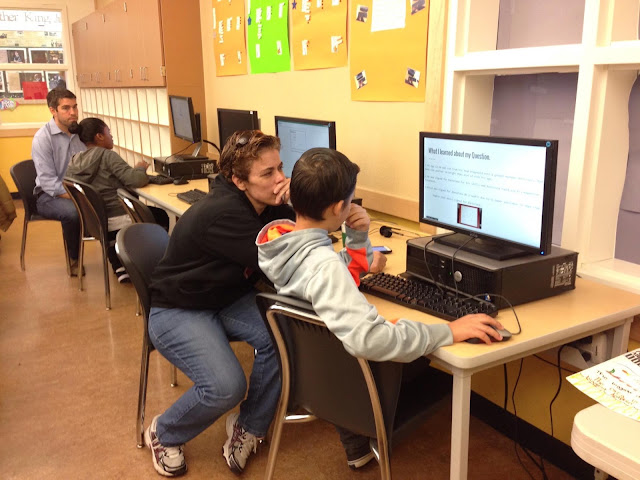Editor's note: Today’s guest author is Susan Gonzalez, district preparation teacher for grades 4-6 at Bayview Elementary School in San Pablo, California and Dr. King, Jr. Elementary School in Richmond, California. West Contra Costa Unified School District introduced a new program to give students time to explore passion projects, based on Google’s concept of 20% time. To learn more about this idea, read Kevin Brookhouser’s blog post about 20% time in schools.
Sixth grader Johntae Tolerson plays basketball every day during recess and dreams of becoming a professional basketball player, but that dream often feels disconnected from the work she does in the classroom. When her school, Dr. King, Jr. Elementary in Richmond, California, gave her 100 minutes a week to explore one of her passions in class, she researched the requirements for becoming a professional basketball player and the background of some professionals in the game.
 |
| Johntae dreams of being a professional basketball player |
Last summer, Google and West Contra Costa Unified School District came together to help launch IDEO’s Teachers Guild, a creative collaborative for teachers to design solutions to the biggest challenges in education today. Teachers and district leaders from around the U.S. went on a design thinking journey to answer the question, “How might we create rituals and routines that establish a culture of innovation in our classrooms and schools?”
 |
| The Teachers Guild brings educators and partners together to tackle big challenges in education today |
The projects range from poetry to fashion design to researching family heritage. I’ve been so impressed by the creativity and personality students have put into their projects. Lashay chose to research her favorite sport, football, and wrote about why boys and girls don’t play football together. MarShawn wrote a poem describing how the emotions he expresses don’t always match how he feels on the inside.
 |
| Katie Von Husen, coordinator of educational technology, helps a student identify his essential question |
Dr. King, Jr. Elementary values positivity, teamwork and support. Since introducing passion projects, I’ve seen students who weren’t always motivated come to class with big smiles and energy. Students shared their projects on a celebratory day at the end of the trial, and it was especially motivating to hear students ask when they would have a second opportunity to pursue a passion project.
We’ve seen this program inspire students like Johntae, Lashay and MarShawn to be critical thinkers and problem solvers while developing their reading and writing skills. It empowered them to take initiative in personalizing their learning, which had the result of boosting excitement about coming to school. The Teachers Guild collaborative helped our school identify how to establish a culture of innovation and better utilize substitute time for passion projects. I encourage all teachers looking to create a culture of innovation to turn underutilized time into opportunities for students to pursue their passions. It truly is a win-win!